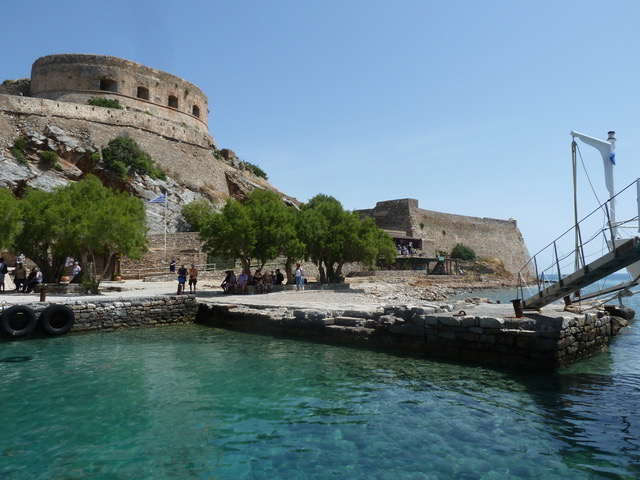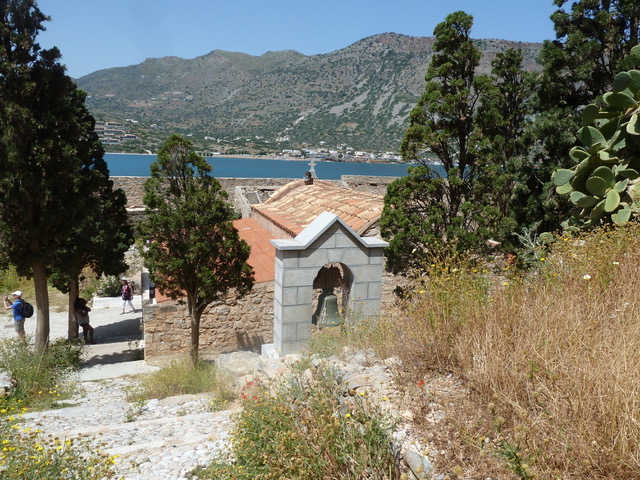Spinalonga Crete, 9 May, 2017 N35:16.026 E025:43.393

ALKIRA
Charles & Maggie Bevis
Tue 9 May 2017 05:50
We are here in the Spinalonga lagoon anchored off the town of Elounda. For those of you that don’t know this area and particularly the story of Spiralonga, we suggest you read the book "The Island” by Victoria Hislop. If you have read the book in the past, it's worth reading again! We arrived here on Friday after a storming sail from Santorini, the whole passage was completed under full sail at speeds between 6 and 9+ knots. Exhilarating and memorable. As we arrived under the cape just North of the entrance, the winds that had served us so well on the passage at first faltered and then we were hit by violent down drafts from the adjacent mountains and obliged to fire up the engine to see us safely into the bay. After a quiet day on Saturday catching up on outstanding jobs (there's no end to these) we took a holiday on Sunday 7 to enjoy the still conditions and took a boat trip to tour Spinalonga Island. Charlie decided the time was ripe to test the waters and swam for the first time this year. Verdict, bracing but quite satisfactory - however, a quick entry was the order of the day or he would have chickened out. Originally built as a fortress by the Venetians in 1210 the island held out against the invading Turks until the 1700’s and even then it surrendered rather than being stormed. As a fortress the island gradually fell into disrepair under the Turks but was finally taken up as a leper colony in 1903. Those unfortunate to be afflicted were forcibly evicted from elsewhere in Crete and later from Athens and transported to the island in horrendous conditions where, in 1904, they adopted the derelict accommodation vacated by the earlier Venetian and later the Turkish occupiers. The lepers were at first supported by the local population who provided food and water, but when our EU friends from Germany arrived the lepers were isolated. By the time our European friends left there only 40 survivors. The colony was briefly re-established after the war before being finally disbanded in 1954. During most of this time, and especially in the early years before the ‘30s, there was no treatment provided and only subsequently was medical aid given.  The landing area on the island  The entrance tunnel to the colony (from the outside)  and from the inside showing the main square.  The elected colony leader’s house  The main street and shopping area  The church, now beautifully restored  A view toward the mainland and Elonda at the head of the bay where we are anchored. Today, it is a sad and melancholy place. Most of the settlement occupied by the lepers is in a dire state of disrepair, but for all that there are signs of a vibrant self sufficient community, that struggled against the odds to do it’s best to survive, with shops, tavernas, bakeries etc etc. Ironically, the place is now a premier tourist venue.   Amongst all the melancholy we found a profusion of beautiful wild flowers growing all around the island and amongst the ruins.  Below is part of the Venetian fort walls  The lagoon here was also an important stepping stone for the imperial flying boats that flew from the UK to India and on to Australia in the 1930’s and 1950’s era. Although there is nothing tangible left of those days, there are a few photographs of the flying leviathans that took 10 days to reach Australia stopping at places en route, such as Elounda, to refuel and allow their passengers ashore to a local hotel for an overnight rest (shades of Easyjet - n'est pas??). We have spent 4 days here and are moving around the corner to Agios Nikolaos today, Tuesday 9. |